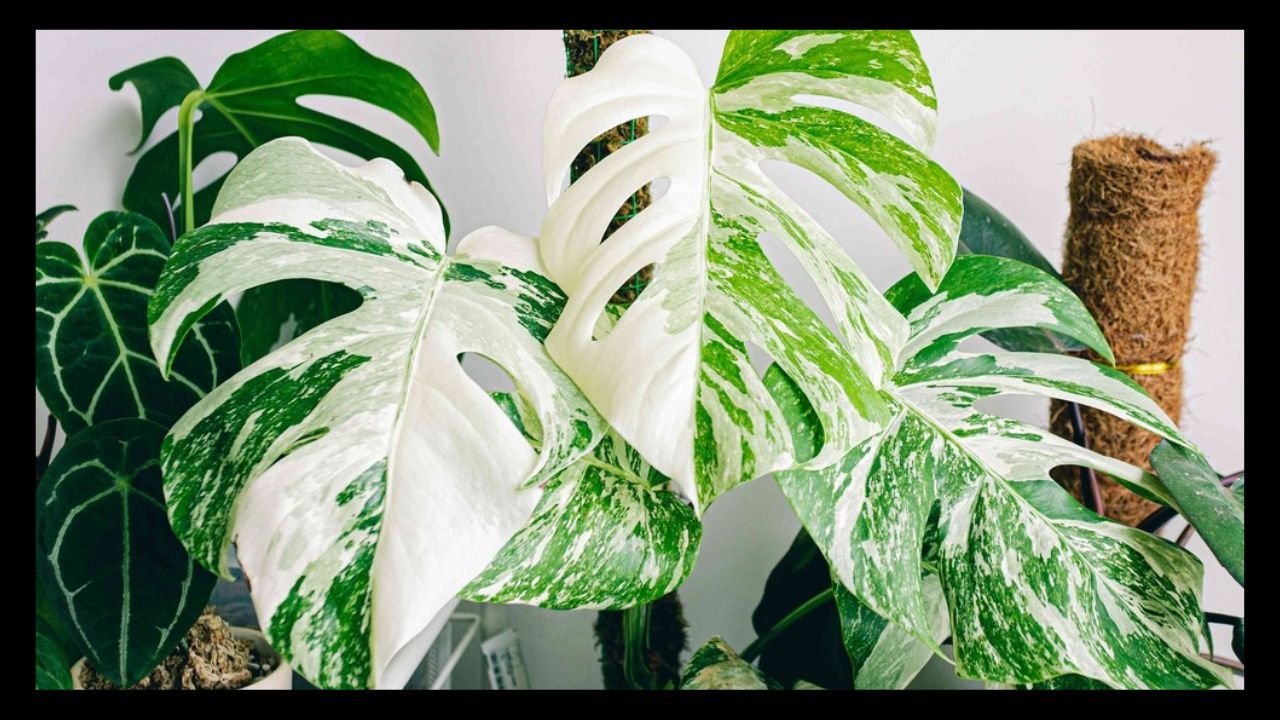Monstera Albo, the coveted variegated beauty, has taken the houseplant world by storm. With its striking white and green marbled leaves, it’s no surprise that Monstera Albo is a must-have for plant enthusiasts and beginner gardeners. Adding a touch of elegance to any indoor space, this plant is perfect for those looking to propagate and expand their collection. Propagating a Monstera Albo might sound intimidating, but it’s surprisingly easy—especially when done in water.
This guide will walk you through what Monstera Albo is, why propagation is valuable, and the step-by-step process to propagate this stunning plant. Whether you’re a beginner or a seasoned plant lover, you’ll find everything you need to care for your Monstera Albo and help it thrive.
What is a Monstera Albo?
The Monstera Albo is a variegated variety of the classic Monstera Deliciosa, known for its iconic, fenestrated (split) leaves. What sets the Monstera Albo apart is its stunning variegation—patches or streaks of white or cream against its lush green leaves. This unique trait makes it highly sought after among plant lovers.
Why is the Monstera Albo so popular?
- Aesthetic appeal: Its variegated leaves make it one of the most Instagram-worthy plants.
- Exclusive nature: Monstera Albo is rarer than its green counterpart, making it a prized possession.
- Easy care: While it looks exotic, the Monstera Albo is relatively easy to care for once you get its needs right.
If you’re fortunate enough to own a Monstera Albo, propagation can be a great way to share its beauty with friends or expand your collection.
What is Propagation, and Why Is It Important?
Propagation is the process of creating new plants from an existing plant. This technique is not only fascinating but also rewarding for any gardener. For the Monstera Albo, propagation in water is one of the easiest and most accessible methods.
Benefits of Propagation
- Save money: Create new plants without buying them.
- Expand your collection: Grow more of your favorite plants from cuttings.
- Preserve rare species: Keep rare plants like Monstera Albo alive and thriving by propagating them.
- Sustainability: Reducing the need to purchase new plants contributes to a more eco-friendly approach to gardening.
Step-by-Step Guide to Water Propagation
Propagating a Monstera Albo in water is straightforward if you follow these steps:
Step 1: Choose the Right Time
It’s best to propagate during the plant’s active growing season, typically spring or summer. During this period, the plant is more likely to develop roots quickly.
Step 2: Select the Perfect Cutting
- Look for a healthy vine with at least one node (the spot where leaves develop) and an aerial root. The node is essential for growth; without it, the cutting won’t root.
- Ensure the cutting has a clean, strong leaf to support photosynthesis during the rooting process.
Step 3: Proper Tools for the Job
Use sterilized scissors or shears to make a clean cut. This prevents the spread of diseases to your plant.
Step 4: Prepare the Water Container
- Fill a glass or jar with distilled or tap water (allow tap water to sit for 24 hours to dissipate chlorine).
- Place the Monstera Albo cutting in the container, ensuring the node is submerged but leaves are not touching the water.
Step 5: Provide Optimal Conditions
- Light: Place the jar in a spot with bright, indirect sunlight. Too much direct sunlight can scorch the leaves.
- Temperature: Maintain a warm environment (65°F-80°F) as Monstera Albo thrives in tropical conditions.
Step 6: Monitor Progress
- Change the water every 5-7 days to prevent stagnation.
- Watch for root development, which typically begins within 2–4 weeks. Roots should be about 2–3 inches long before transferring to soil.
Common Mistakes to Avoid
Even seasoned plant enthusiasts can make mistakes during propagation. Here are some common pitfalls and how to avoid them:
- Skipping the node: Without a node, the cutting won’t develop roots. Ensure at least one node is included.
- Submerging the leaves: Leaves in water can rot and contaminate the cutting.
- Using dirty tools: Always sterilize tools to prevent disease.
- Neglecting water changes: Failing to refresh the water can lead to bacterial growth and root rot.
Caring for Your Propagated Monstera Albo
Once your new Monstera Albo cutting has developed strong roots, it’s time to pot it and care for it as a thriving plant. Here’s how:
Potting Up
- Use a well-draining potting mix suitable for tropical plants. A mix of peat, perlite, and orchid bark works great.
- Choose a pot with drainage holes to prevent waterlogging.
Watering
- Water your plant when the top 2 inches of soil feel dry. Overwatering can lead to root rot, a common issue with Monsteras.
Light
- Place your plant in bright, indirect sunlight. Avoid direct sun, as it can scorch the delicate variegated leaves.
Humidity and Temperature
- Monstera Albo thrives in high humidity. Mist the plant or use a humidifier to replicate its natural environment.
Fertilizing
- Feed your plant with a balanced liquid fertilizer every 4-6 weeks during the growing season.
You May Also Like: Scimitar Drum History and Types Explained
Conclusion
In conclusion, Monstera Albo is a stunning and sought-after plant that requires specific care to thrive in your home. By following the guidelines provided for watering, light, humidity, temperature, and fertilizing, you can ensure that your Monstera Albo remains healthy and vibrant. Additionally, addressing common concerns and misconceptions through the frequently asked questions section allows you to troubleshoot common issues and provide the best possible care for your plant. With proper attention and care, your Monstera Albo will flourish and become a beautiful addition to your indoor plant collection.
Frequently Asked Questions
How long does it take for a Monstera Albo cutting to root in water?
It usually takes 2–4 weeks for the roots to develop, depending on the environment and care provided.
Why is my Monstera Albo cutting not rooting?
Possible reasons include lack of a node, poor water quality, or insufficient light. Ensure the cutting has a node and receives bright, indirect sunlight.
Can Monstera Albo survive in water long-term?
While Monsteras can survive in water for extended periods, they thrive better when transferred to soil after the roots have developed.
Is the Monstera Albo pet-friendly?
No, Monstera Albo is toxic to pets if ingested. Keep it out of reach of cats and dogs for their safety.
How often should I change the water during propagation?
Change the water every 5–7 days to prevent bacteria buildup and promote healthy root growth.









